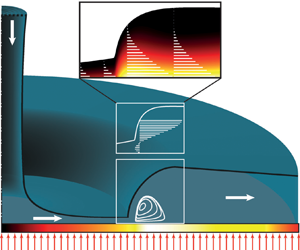No CrossRef data available.
Article contents
Averaging theory for heat transfer in circular hydraulic jumps with a separation bubble
Published online by Cambridge University Press: 18 January 2024
Abstract

Analytical investigations of heat transfer during the vertical impingement of an unsubmerged axisymmetric liquid jet on a horizontal plate have been limited to the regions ahead of the jump. This limitation is due to the complex flow physics in the jump region arising from sudden changes in the flow field. This is addressed in here by extending the averaging theory (AT) introduced by Bohr et al. (Phys. Rev. Lett., vol. 79, issue 6, 1997, pp. 1038–1041) which was further developed by Watanabe et al. (J. Fluid Mech., vol. 480, 2003, pp. 233–265), to describe the heat transfer problem in circular hydraulic jumps including separation. The applicability of the resulting theory to determine the temperature field in the jump region is evaluated using the data available in the literature and also by means of fully resolved numerical solutions. Good agreement is observed for moderate Prandtl numbers. However, for sufficiently high Prandtl numbers, deviations become notable. The reasons for the deviations according to their relevance are (i) monotonically decreasing temperature profile inherent to the AT, whereas the fully resolved numerical solutions exhibit a local maximum in the temperature profile away from the plate; and (ii) inapplicability of the concept of dividing the flow field into a region affected and a region unaffected by heat transfer according to the thermal boundary layer thickness. This concept leads to the overestimation of the temperature close to the wall and to the existence of a threshold Prandtl number, for which the thermal boundary layer thickness does not meet the free surface anymore. Around this threshold Prandtl number, the temperature field shows a discontinuous behaviour.
Information
- Type
- JFM Papers
- Information
- Copyright
- © The Author(s), 2024. Published by Cambridge University Press


